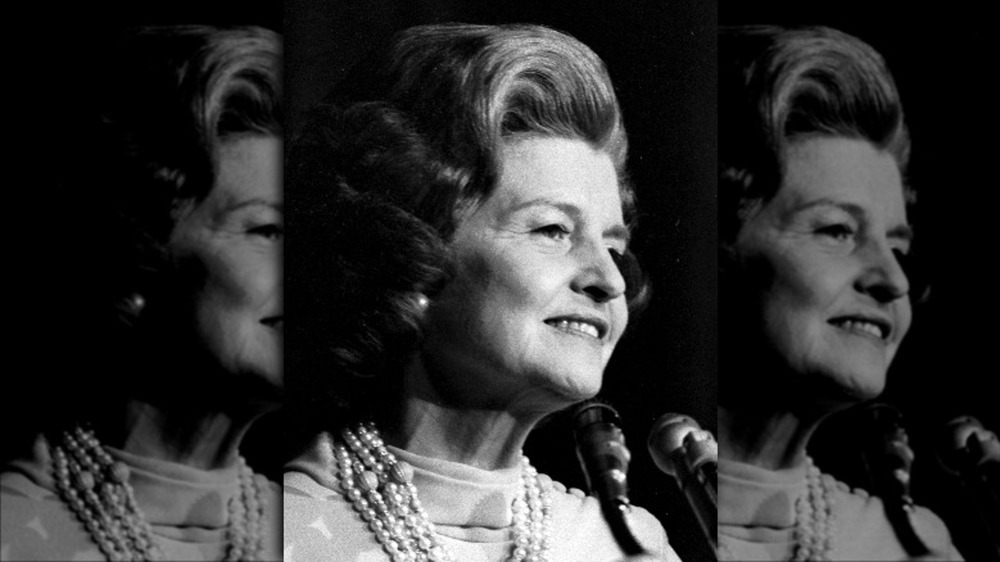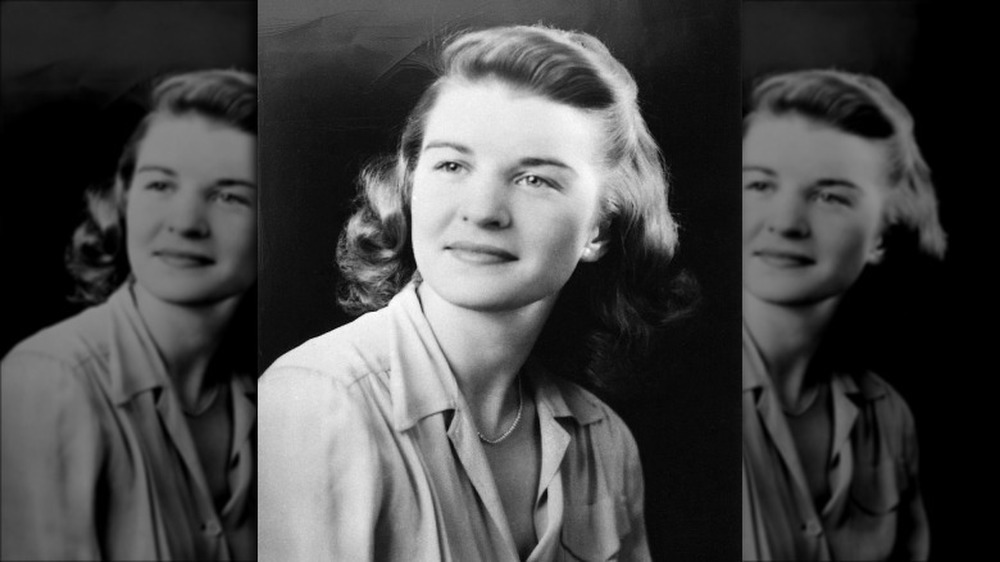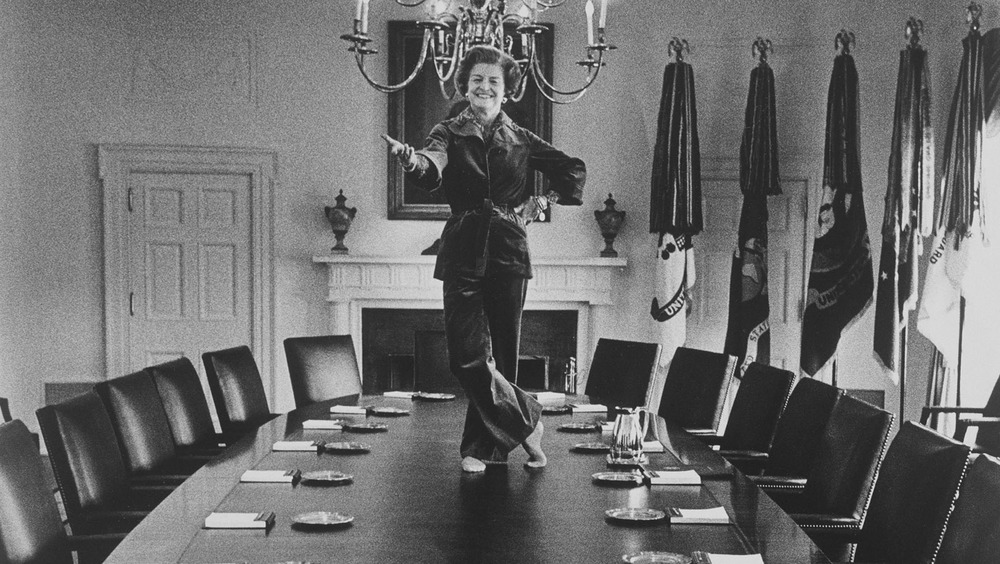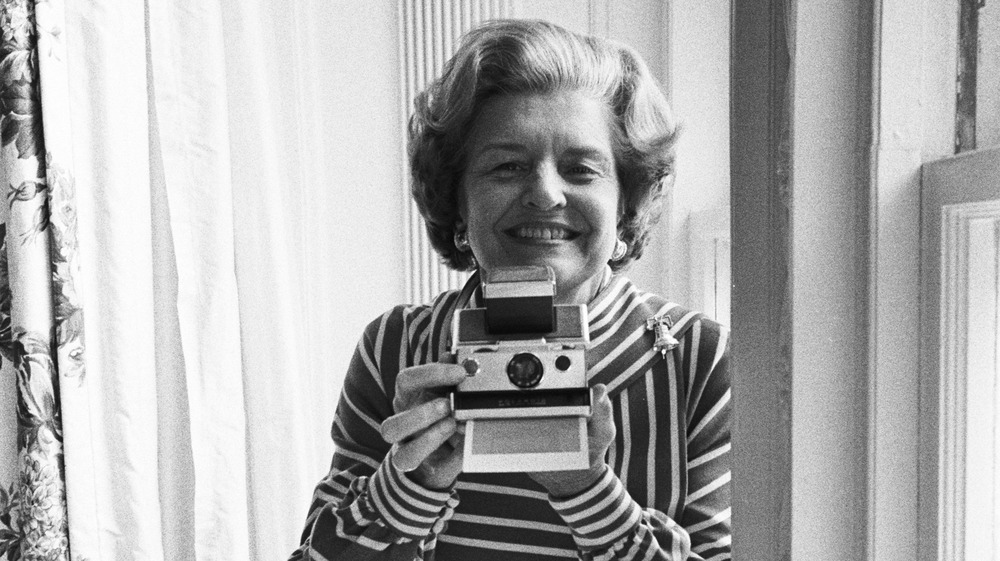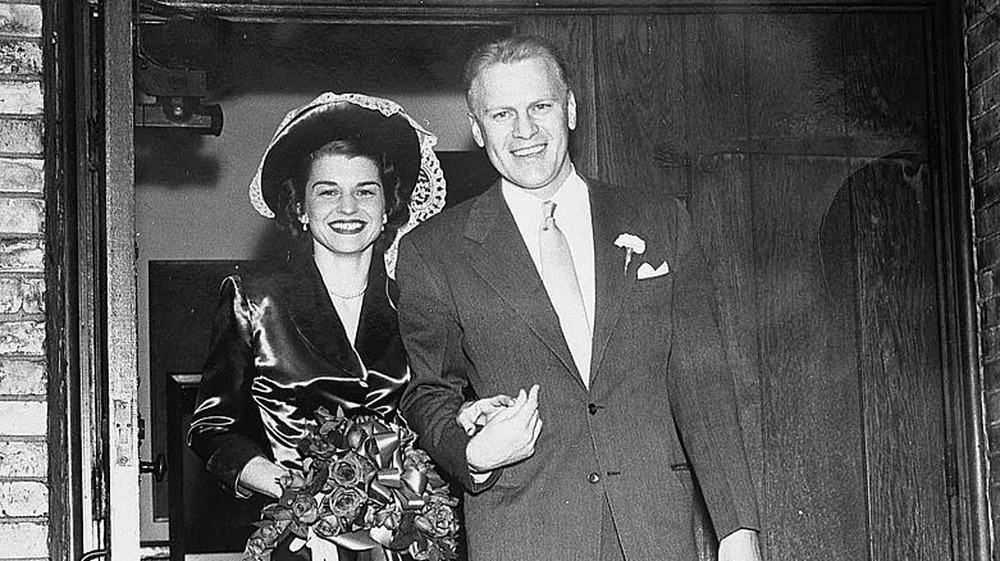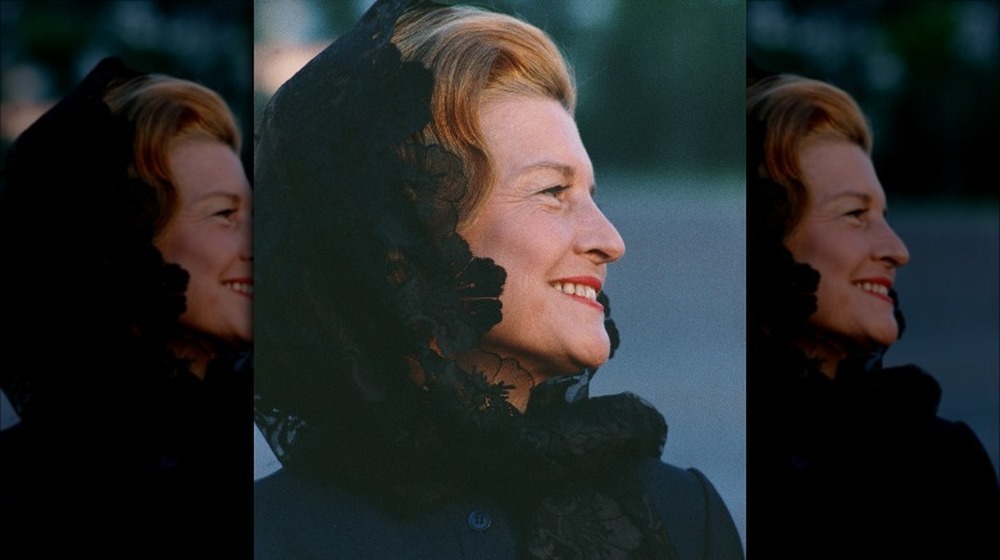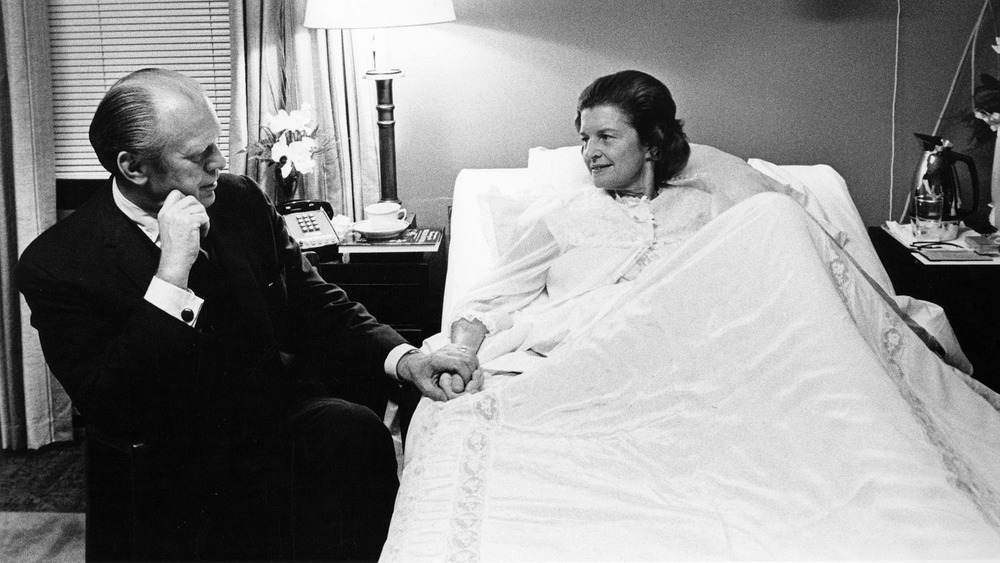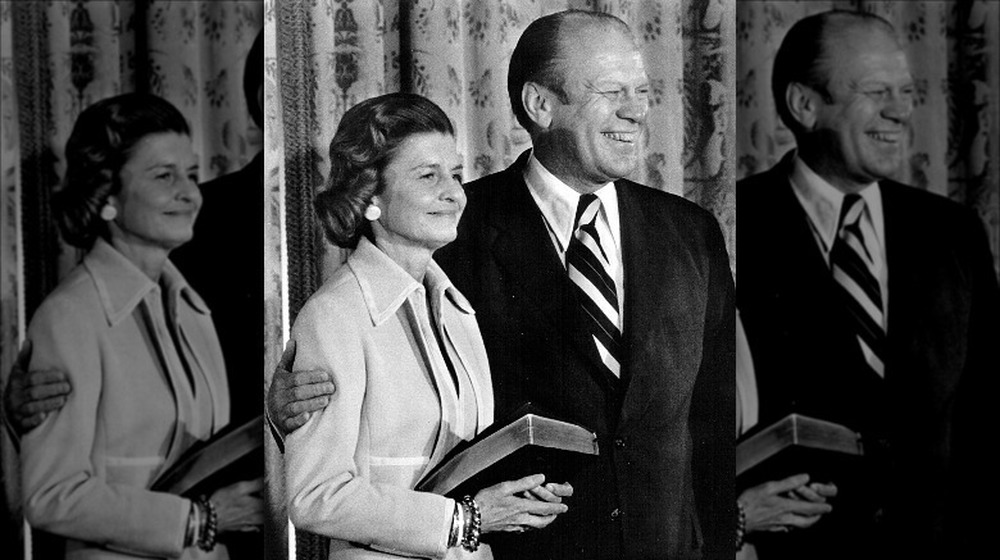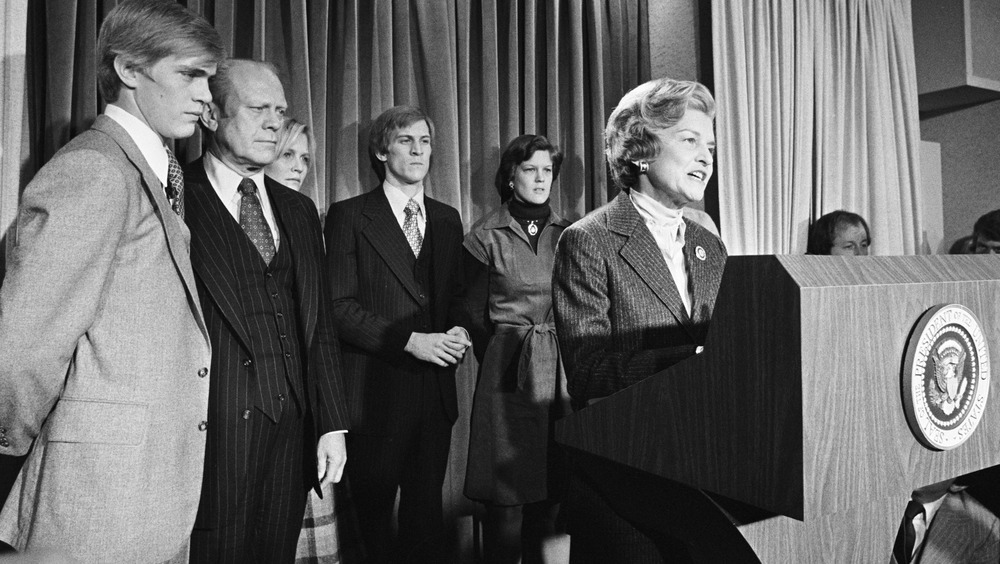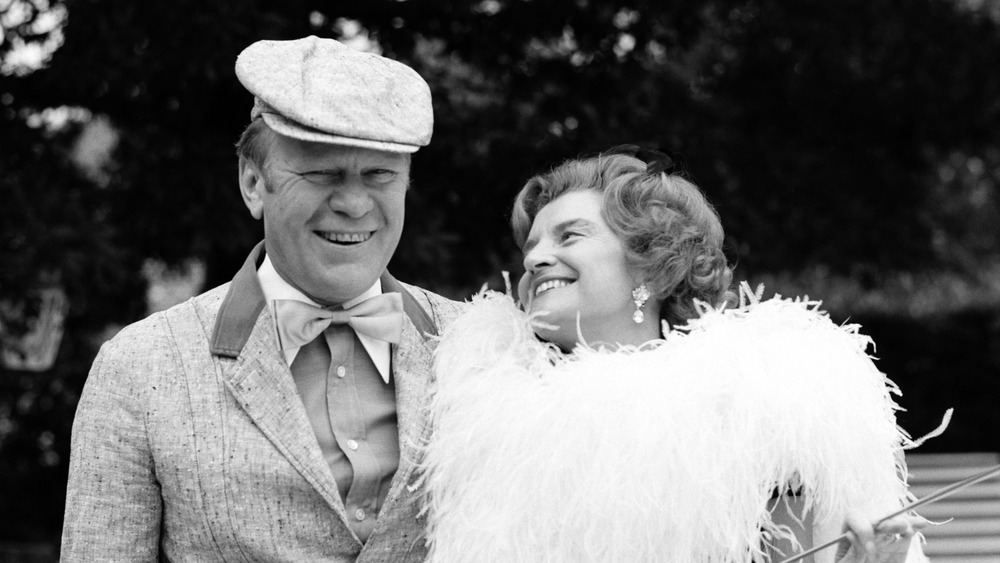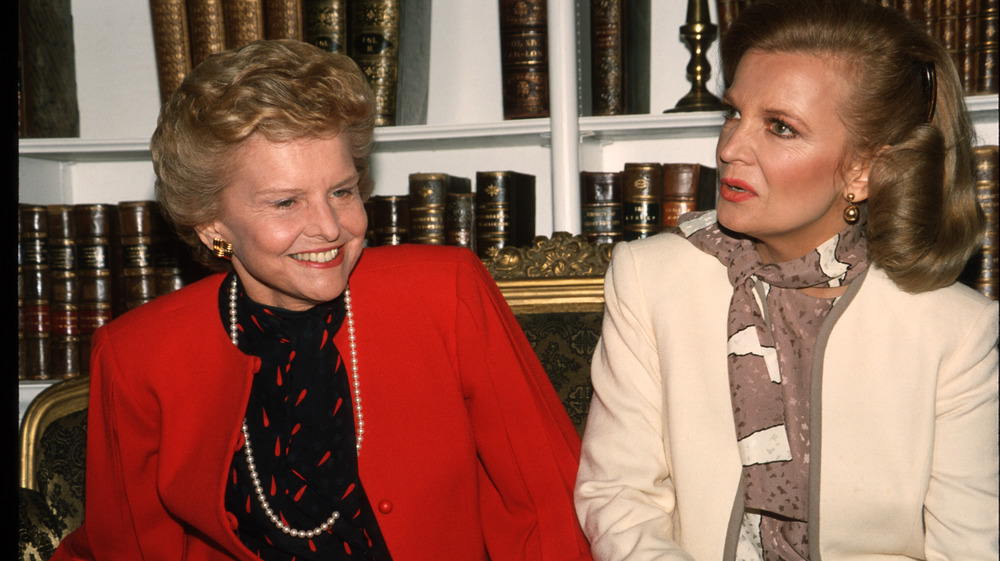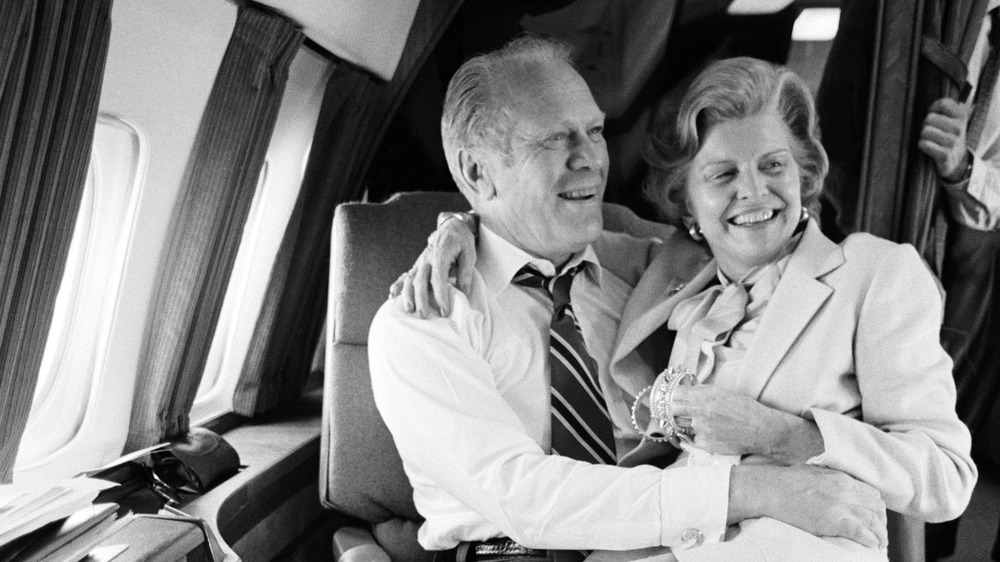The Tragic Real-Life Story Of Betty Ford
First Ladies don't always get their due because they're usually overshadowed by their husbands—the men elected President of the United States. This isn't always fair, of course; there are plenty of examples of First Ladies who matched—or excelled—their husbands in terms of brains, political acumen, and achievement. But it's hard to compete with someone who becomes the most powerful person in the world.
Every mold is made to be broken, and our 38th First Lady did just that. Elizabeth Anne Ford, better known as Betty, was outspoken, opinionated, and vivacious. She became an icon not because of her flaws, but because she faced those flaws with honesty and surprising strength and dignity. Betty Ford did much to normalize the idea that addiction is a disease—so much so that her namesake treatment center remains shorthand for substance abuse treatment.
Betty Ford lived a long, rich life before her husband became president and before her private struggles became public knowledge. Far from being defined solely by the political achievements and disappointments of Jerry Ford, Betty carved her own legacy. Yet many people aren't aware of her story. Here, then, is the tragic real-life story of Betty Ford.
Her father died when she was just 16
Elizabeth Anne Bloomer was born in 1918 to William Bloomer and Hortense Neahr. She was the couple's third child and only daughter. According to History, the Bloomers were wealthy: Her mother's family owned a thriving furniture business, and her father worked for the Royal Rubber Company in Grand Rapids. He was also likely an undiagnosed alcoholic for most of his life.
As People reports, Betty turned 16 in 1934. It was the height of the Great Depression, and her father had recently lost his job, which likely worsened his drinking problem. On the day before his 60th birthday, William Bloomer went out to the garage to work on the family car. Betty came home to find their garage door open, and her father dead. The keys to the car were in the ignition, and the gas tank was empty, implying the car had been left to run until it ran out of gas. The official cause of death was listed as carbon monoxide poisoning despite the garage door being open, but Betty acknowledged later in her life that her father very likely died by suicide. She recalled that the first time she heard someone call her father an alcoholic was at his funeral.
Betty Ford wanted to be a professional dancer
As History tells us, Betty's mother Hortense was a woman who valued "social graces." She wanted to raise Betty to be a traditional society wife, and she began training her daughter in the role at a very young age. When Betty was just 8-years-old, her mother enrolled her in dance classes at the Calla Travis Dance Studio in Grand Rapids.
What was supposed to be part of Betty's charm school training, however, quickly developed into a passion. By 14, Betty was helping to teach the next generation of dancers ballet, tap, and even modern dance. When she graduated, she went to Vermont to attend the Bennington School of Dance for two years, paying her own tuition with money she earned working in a department store. In 1940, when Betty was 22, she moved to New York City to pursue a professional dancing career.
Her mother was horrified. As Your Dictionary notes, Betty's mother convinced her to move back to Michigan in 1941. Betty took a full-time job at a local department store and excelled at it, earning several promotions. She gave up on a dance career, but not on dance itself—she continued to give dance lessons, and danced for herself throughout her life. In fact, as Smithsonian Magazine reports, Betty Ford hopped up onto the cabinet table in the White House on her final day as First Lady and famously danced for an iconic photograph.
Her first marriage was tragic
Betty Bloomer returned to Grand Rapids from New York in 1941 and immediately became a hot commodity on the marriage circuit. She began dating a childhood friend named William Warren. History notes that Betty and Bill had known each other since the age of 12, which gives the romance all sorts of romcom overtones.
But as MLive reports, Betty's mother and new stepfather didn't approve of Warren, who drank heavily and was known as a "free spirit." They didn't say anything explicitly to Betty, though, and in 1942 the young couple announced their engagement, and they were married soon thereafter.
Bill worked as a traveling salesman, and he changed jobs frequently. Every time he took on a new territory, the couple would move, and Betty would find work at a local department store. But Bill often stayed out late, and his health deteriorated due to diabetes and his drinking. Betty became increasingly unhappy because she wanted a more stable life, with a permanent home and kids. After a few years she decided she wanted a divorce—but just as she was writing Bill a letter asking for one, he fell into a diabetic coma. Betty spent several months dutifully caring for her ailing husband, but when he was healthy again, she divorced him.
Betty Ford's marriage to Jerry was affected by politics
After extricating herself from her first marriage to Bill Warren, Betty didn't stay single for very long. Being a divorced woman in 1948 carried a bit of a stigma, but that didn't deter an ambitious young politician named Gerald Ford. Jerry, as she called him, was a hotshot lawyer and a former college football star, and by all accounts their romance quickly became an enduring, lifelong passion—but as MLive notes it was marred by politics from the very beginning.
Jerry asked Betty to marry him in 1948—but immediately delayed their wedding ceremony because he was running for Congress and had to concentrate on his campaign. This was more than just making schedules work, though. As The New York Times reports, Jerry was worried about the reaction of his conservative Republican supporters if he married a divorced ex-dancer, and thought delaying their marriage would be the prudent decision.
The trend continued: Jerry showed up late to their wedding because he attended a campaign event earlier in the day. Somehow, Betty overlooked these offenses and the Fords remained married for the next 58 years, until Jerry passed away at the age of 93 in 2006.
Betty Ford spent half her life in debilitating pain
Betty Ford was a physical young woman. Her biography at First Ladies' Library describes the young Betty Bloomer as "active" and healthy, and as History notes, she was an accomplished dancer who probably could have pursued a professional dance career. Overall, the picture painted of the young Betty Ford is one of an athletic, capable woman.
As biographer Jeffrey S. Ashley writes, however, all that changed when Betty was in her mid-40s. In 1964, Betty Ford was in her kitchen and leaned over the sink to open a window. She didn't think anything of it at the time, but later that night she woke up in excruciating pain. Doctors eventually diagnosed a pinched nerve, a fairly common injury that should have been easy to deal with.
Instead, her condition worsened. The pain was incredible, and Betty could barely stand on her own. She was given more pain medications until doctors eventually realized she was also suffering from an early case of osteoarthritis. She lived the rest of her life in pain, but forced herself to find ways to move, relying on an increasing intake of pills and alcohol to get through her days. Despite her efforts, she lived the rest of her life in constant pain.
Betty Ford survived breast cancer
Jerry Ford became Vice President of the United States in 1973 when Richard Nixon's running mate Spiro Agnew resigned in disgrace. Less than a year later, Nixon himself resigned when the mounting Watergate Scandal seemed to guarantee his imminent impeachment—and Gerald Ford became President of the United States. Which meant Betty Ford suddenly found herself the First Lady.
This should have been a moment of triumph for the Fords, but it was almost immediately undermined by a health crisis. As reported by Cancer Today, Betty accompanied a friend to a breast exam, and her friend encouraged her to have one as well. That impulsive decision saved her life: The doctor found a marble-sized lump in her breast, and two days later she underwent a radical mastectomy. Doctors removed her right breast entirely, along with some pectoral muscle and the lymph nodes.
Betty Ford reacted to this setback in what would become known as typical fashion for this First Lady. Instead of keeping her health struggles secret as would be expected, she made them public, and used her position as First Lady to drive awareness of breast cancer and the power of self-examination for women. She's credited with normalizing discussions of cancer and women performing their own breast exams, and, as noted by the History News Network, is considered one of the early leaders of the women's breast cancer movement.
Betty Ford was a controversial First Lady
When Betty Ford became First Lady in 1974, it was a time of rapid change in America when it came to women's roles. The President's wife had long been expected to silently support her husband, and to engage mostly in social and charitable work. But as The Sunday Post makes clear, Betty had little patience for these expectations.
As Cancer Today notes, one of her first official acts was to hold a press conference—the first press conference held by a First Lady since 1953. That set the tone: Ford became one of the most outspoken and opinionated First Ladies in history. She broke so many taboos it's difficult to list them all—as People notes, she spoke about the Equal Rights Amendment, speculated about her children's drug use, and shocked the country by discussing the sleeping arrangements with her husband.
But her most shocking deviation from tradition was her vocal support for abortion rights. This support not only put her in opposition to most of her fellow Republicans, it was also the opposite of her husband's views. This led to the incredible situation where a First Lady openly disagreed with the President on a huge issue. As History notes, Republican leaders began referring to her as "No Lady" and even furiously demanded her "resignation" as First Lady.
Betty Ford had to concede the election for her husband
Gerald Ford became President of the United States in 1974 without ever having run for the office. Ford was a brilliant politician who'd risen to the position of Minority Leader of the Republican caucus in the House of Representatives but seemed stuck there. The New York Times reports that in 1974 he even told Betty he would make one last campaign push to gain the majority and become Speaker of the House—and if he failed, he would retire.
Then, as History reminds us, Vice President Spiro Agnew resigned in the midst of a corruption scandal. President Richard Nixon had to appoint a replacement that would be easily confirmed—and Jerry Ford was the obvious choice. Only a few months after becoming vice president, Ford found himself rising to the position of Commander in Chief when Nixon himself resigned to avoid impeachment.
Gerald Ford served 896 days as president, and his key achievement was restoring some sense of dignity to the office. He finally ran for president in 1976, but couldn't shed the Watergate baggage and lost to Jimmy Carter. As The New York Times notes, Ford had campaigned himself hoarse in the days before the election, so when the time came to admit defeat it fell to Betty to get up in front of the cameras and concede the election she and Jerry had worked so hard towards—smiling graciously the whole time.
Betty Ford was an addict and an alcoholic
Betty Ford was an icon for many—a champion of women's rights and an outspoken supporter of women's health. But what most people think of when they think of Betty Ford is her struggle with addiction and alcoholism.
As noted by the National First Ladies' Library, Ford's family had a history of alcoholism—her father and brother were both very likely alcoholics, and alcoholism likely contributed to her father's death at the age of 59. But for much of her early life Betty Ford's drinking wasn't terribly problematic, especially during a time in the 20th century when heavy drinking was more socially acceptable than today and the concept of alcoholism as a disease hadn't yet become commonly understood.
But as biographer Jeffrey S. Ashley writes, everything changed when Ford pinched a nerve in her neck in 1964. The pain was excruciating, and never went away, and Ford dealt with it by taking a lot of prescription painkillers and drinking even more. As History notes, her drug abuse receded somewhat while she was First Lady—but then got worse when she left the White House. It all culminated in a family intervention staged in 1978. Ford admitted she had a problem and agreed to enter a rehabilitation center. Her experience in recovery inspired her to speak out about addiction issues and to found the Betty Ford Center.
Betty Ford resisted admitting she was an alcoholic
People with addiction problems often justify their behaviors in a variety of ways, or outright deny they have a problem. History notes that Betty Ford's concerned family staged an intervention in 1978 and convinced her that her painkiller addiction needed to be treated. But as The Detroit News reports, Ford hadn't yet reached full acceptance of her problem.
Betty Ford was initially only willing to admit that she'd become addicted to pain pills, and refused to consider that she might have a drinking problem. The pain medications had been prescribed, so she was able to rationalize her addiction as something normal. An addiction to prescribed medications didn't have the same stigma that alcoholism still had in the 1970s—alcoholics were sometimes perceived as morally weak, and drinking problems were still thought of as primarily willpower problems.
Ford had an epiphany while in treatment, however. She observed another patient denying that her obvious alcoholism had caused anyone any pain—and realized this was exactly what she was doing. At the age of 60, Betty Ford finally admitted she was an alcoholic as well as a drug addict, and finally sought help for her substance abuse problems.
A heart condition came close to killing her
For the first few decades of her life, Betty Ford was blessed with great health. A talented dancer, she had an athletic constitution and no major health crises until she was in her forties. Then things began to take a turn: Her biographer Jeffrey S. Ashley writes that in 1964 she suffered a pinched nerve that, exacerbated by arthritis, left her in terrible pain for the rest of her life. In 1974, according to Cancer Today, she was diagnosed with breast cancer and had to undergo a radical mastectomy. And then History notes that in 1978 her family staged an intervention and she finally admitted to being addicted to prescription pills and an alcoholic.
But her health battles weren't over. As The New York Times reports, less than 10 years later a blockage was detected in her right carotid artery, and she had to enter the hospital at the age of 69 to undergo quadruple bypass surgery. Although the initial procedure went well and she returned home, The Los Angeles Times reports that she endured a series of complications over a five-month period that required four more surgeries to correct. She went on to live another 24 years in relatively good health.
Betty Ford truly loved Jerry
The marriages of some politicians are more about appearances and connections than love and passion—but Betty and Gerald Ford were the exception. Jerry spent nearly three decades in Congress before becoming first Vice President and then President, and MLive reports that Betty routinely took their four children to visit him at work on the weekends, spending time reading while the children played. And The Saturday Evening Post reports that she often read the Bible with Jerry, and then prayed with him in the evenings. The Fords were also extremely affectionate with one another—Betty once answered a question about how often they slept together by saying, "As often as possible!"
After the presidency, the Fords remained devoted to each other. When Jerry grew ill in 2006, Betty oversaw the transformation of their home into a hospital ward to care for him. When he died five years before her in 2006, she was heartbroken. Although not in the best of health herself, the Gerald Ford Foundation shows that Betty insisted on participating in the state ceremonies to honor her husband, traveling from California to Washington, D.C. and then to Grand Rapids in order to take part.
